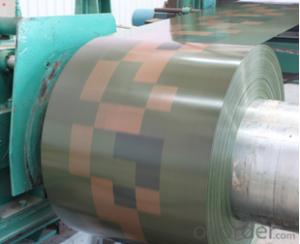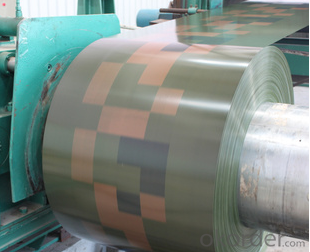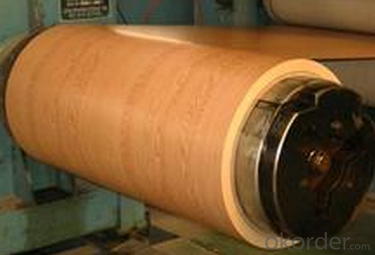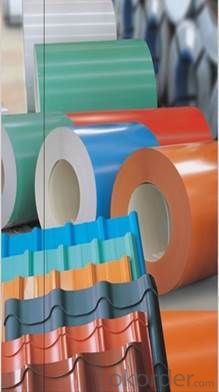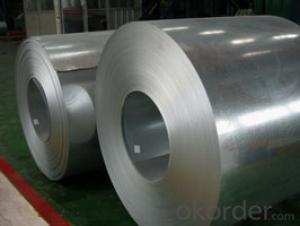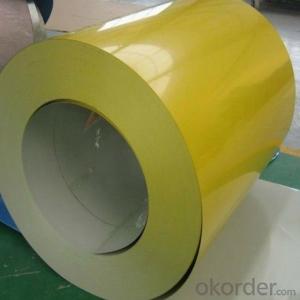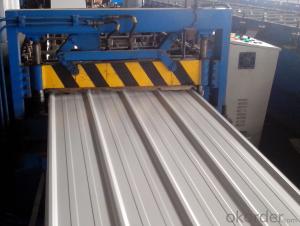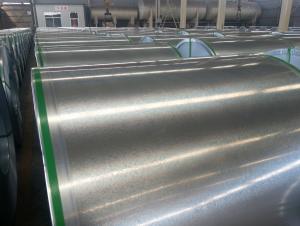Color coated galvanized steel coils SGCC, DX51D,China origin
- Loading Port:
- China main port
- Payment Terms:
- TT OR LC
- Min Order Qty:
- 1 m.t.
- Supply Capability:
- 1000000 m.t./month
OKorder Service Pledge
OKorder Financial Service
You Might Also Like
1) AVAILABLE DESIGNATION OF (Prepainted galvanized steel coils) printed PPGI coils
Quality Q/BQB 440-2003 JIS G3312-1994 EN 10326-2004 ASTM A653-02a
EN 10327-2004 (BASE PLATE)
(BASE PLATE)
Commercial Steel TDC51D CGCC DX51D+Z/AZ CS Type A/B/C
Forming Steel (TSt01,TSt02,TSt03) CGCD1 FS Type A, Type B
Drawing TDC52D /TDC53D - DX52D+Z/AZ DDS TYPE A/C
Steel DX53D+Z/AZ
Structural TS280GD(TStE28) CGC400 S280D+Z/AZ SS275
Steel TS350GD(TStE34) CGC440 S350D+Z/AZ SS340 Class1
2) OUR SPECIFICATION OF (Prepainted galvanized steel coils) printed PPGI coils
Available Size:
Manufacturer Thickness Width Length of plate Inner diameter of coil
JIANGSU HUIYE STEEL SHEET CO.,LTD 0.2-1.2mm 800/914/1000/1200/1219/1250mm 1000-6000mm 508mm/610mm
Coated Mass OF (Prepainted galvanized steel coils) printed PPGI coils:
Base plate Available Coated Mass(g/m^2)
Galvanized Steel 80, 100, 120, 160, 180
Galvalume Steel 50, 70, 150
Available Painting OF (Prepainted galvanized steel coils) printed PPGI coils:
Category of Painting Item Code
Polyester PE
High-durability polyester HDP
Silicon modified polyesters SMP
Polyvinylidene fluoride PVDF
Easy-Cleaning —
Painting Thickness Top side: 20+5microns;
Bottom side: 5~7microns.
Color System Produce according to RAL Color System or as per buyer’s color sample.
Painting structure Top surface Bottom surface
Primer coating No coating 1/0
Primer coating Primer coating 1/1
Primer coating + Finish coating No coating 2/0
Primer coating + Finish coating Primer coating or single back coating 2/1
Primer coating + Finish coating Primer coating + Finish back coating 2/2
- Q: How are steel coils used in the manufacturing of pipes?
- Steel coils are used in the manufacturing of pipes as they provide the raw material needed for pipe production. The coils are uncoiled and then passed through a series of machines, where they are shaped, welded, and cut to the desired length and diameter. This process allows for efficient and precise pipe manufacturing, ensuring the strength and durability of the final product.
- Q: Im getting a new guitar soon, and it has steel strings. ive heard that nilon strings are better? thanks:)
- Nylon is allegedly better for beginners because they don't cut into the fingers as much. Steel sounds much better, though.
- Q: What are the challenges in coil recoiling?
- Coil recoiling, also known as coil winding, can pose several challenges depending on the specific application and requirements. Some of the common challenges in coil recoiling include: 1. Precision and accuracy: Achieving precise and accurate winding is crucial for optimal coil performance. Maintaining consistent tension throughout the winding process, ensuring proper alignment, and controlling the speed are essential to avoid variations in the coil's electrical properties. 2. Wire management: Handling the wire during the recoiling process can be challenging. The wire may be delicate, prone to tangling, or have specific handling requirements, such as being magnetically or thermally sensitive. Proper wire management techniques, such as tension control, wire guide systems, and spooling mechanisms, need to be employed to prevent wire damage and ensure uniform winding. 3. Space constraints: In many applications, coils need to fit within specific space limitations. Designing and winding coils to fit compact spaces can be challenging, especially when considering the required number of turns, wire size, insulation, and any additional components or structures that may need to be incorporated. 4. Material selection: Selecting the appropriate wire and insulation material is crucial for coil performance and longevity. Factors such as electrical conductivity, thermal properties, mechanical strength, and chemical resistance need to be considered to ensure the coil can withstand the operating conditions and environmental factors it will be exposed to. 5. Heat dissipation: Coils often generate heat during operation, especially in high-power applications. Efficient heat dissipation is essential to prevent overheating and ensure the longevity of the coil. Designing the coil with proper ventilation, utilizing cooling mechanisms, or integrating heat sinks are some of the techniques used to address this challenge. 6. Quality control: Ensuring consistent quality in coil recoiling can be challenging due to factors such as variations in wire properties, operator skill, equipment calibration, and environmental conditions. Implementing robust quality control measures, such as conducting regular inspections, performing electrical tests, and monitoring process parameters, is necessary to maintain consistent coil performance. Overall, coil recoiling requires attention to detail, precision, and adherence to specific requirements to overcome the challenges and produce high-quality coils that meet the desired performance criteria.
- Q: I am doing an assignment for my materials class, im not asking for the answer but just some help. I have the assignment finished and handed in but the teacher gave it back with one comment, he asked me to explain the grain growth in steel during hydraulic press bending. Im completely stuck, please help. Thanks.
- when you press bend metal , its gets a little hotter at the point of the bend , its like bending a piece of metal back and fourth , the area of the bending gets hot .the distance between the atoms at that point expands thus, a small growth in the size of the metal
- Q: Eutectoid Steel
- Eutectic steel is used to produce pearlite, bainite, spheroidite and martensite steels. Those steels vary in strength, hardness and ductility. One uses martensite steel for example in razor blade manufacturing. Of course there is no end to the various uses of these steels.
- Q: Does te game end with broken steel? What is broken steel? I bouht it cuz my buddy said I should.
- Broken Steel is an addon that lets you continue the story after the business with the final battle for the Purifier and extends to level cap to... 30? 40? Can't quite remember. In Broken Steel you side with the BoS to wipe up what is left of the Enclave in the Capital Wastelands, in the end infiltrating and (possibly) destroying a huge armored crawler-base (or you can blow up the Citadel, the BoS HQ, your call). Anyway the game won't end after your final decision and you can continue wreaking havoc over the wasteland, exploring, whatever.
- Q: What are the common coil slitting methods?
- The common coil slitting methods include rotary shear slitting, loop slitting, and single-knife slitting.
- Q: what are the characteristics when of iron or steel when stretched? which one could be stretched further? which one stretches more evenly?thankyou
- Technically, this is known as ductility. a material which can be permanently bent and stretched is said to be ductile. Pure iron, when it lacks carbon and impurities like sulfur and phosphorus, is relatively soft, ductile, and weak. It's about as soft as brass. It can be stretched to about 50% of it's original length before it breaks. The amount a sample can be stretched without breaking is known as elongation. The key to steel is the addition of about 2 parts per thousand of carbon, or around 0.2%. This alters the crystal structure and makes steel much harder, stronger, and tougher, though it also becomes somewhat less ductile. Mild steel, with a low carbon content, has an elongation of around 30% Adding more carbon makes the steel yet stronger, but further reduces the elongation. Adding more than 2-3% carbon produces what is known as Cast Iron. Cast iron is brittle. It has virtually no ductility. It's pretty cheap to produce though.
- Q: What are the applications of steel coils in automotive manufacturing?
- Due to their unique properties and characteristics, steel coils find a wide range of applications in automotive manufacturing. They offer numerous benefits and contribute significantly to the overall performance, safety, and reliability of automobiles. One primary application of steel coils in automotive manufacturing is their use in the production of body panels. These coils are employed to create the outer body structure of vehicles, including doors, hoods, fenders, and roofs. The exceptional strength and durability of steel make it an ideal material for these components, providing protection against impacts and enhancing the overall structural integrity of the vehicle. Automotive chassis and frames also rely on steel coils during their manufacturing process. The robust and rigid nature of steel makes it an excellent choice for these critical components, enabling them to withstand heavy loads and provide stability to the vehicle. Steel coils ensure that the chassis and frames possess the necessary strength and stiffness to support the weight of the vehicle and endure the forces experienced during driving. Moreover, steel coils play a crucial role in the production of various suspension and steering components, such as springs, stabilizer bars, and control arms. These parts require high strength and resistance to fatigue, as they constantly face stress and vibrations. Steel coils provide the required toughness and flexibility to these components, ensuring smooth and controlled vehicle handling. Furthermore, steel coils find application in the manufacturing of engine parts and exhaust systems. The high-temperature resistance and corrosion resistance of steel make it an ideal material for these purposes. Steel coils are shaped into various forms, including tubes and pipes, to create exhaust manifolds, catalytic converters, and mufflers. They play a significant role in enhancing the performance and efficiency of the engine while reducing harmful emissions. In summary, steel coils are indispensable in automotive manufacturing due to their strength, durability, and versatility. They are utilized in the production of body panels, chassis, suspension components, engine parts, and exhaust systems. The incorporation of steel coils in these applications ensures the safety, reliability, and optimal performance of vehicles, making them an essential material in the automotive industry.
- Q: I mean about if I had a piece of metal, how can i decide that's iron or steel?Sorry for bad English.
- Iron is a chemical element with the symbol Fe, that has no engineering application as it is very soft. You are not likely to come across a piece of metal of pure Iron. Steel is an alloy of Iron that is widely used with different types for various application. The type depends on the alloying elements. An old and rough way of identifying them is to use a chart, that shows the spark pattern when they are subjected to grinding.
Send your message to us
Color coated galvanized steel coils SGCC, DX51D,China origin
- Loading Port:
- China main port
- Payment Terms:
- TT OR LC
- Min Order Qty:
- 1 m.t.
- Supply Capability:
- 1000000 m.t./month
OKorder Service Pledge
OKorder Financial Service
Similar products
Hot products
Hot Searches
Related keywords
